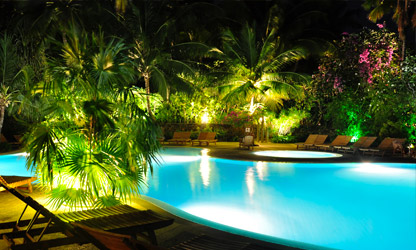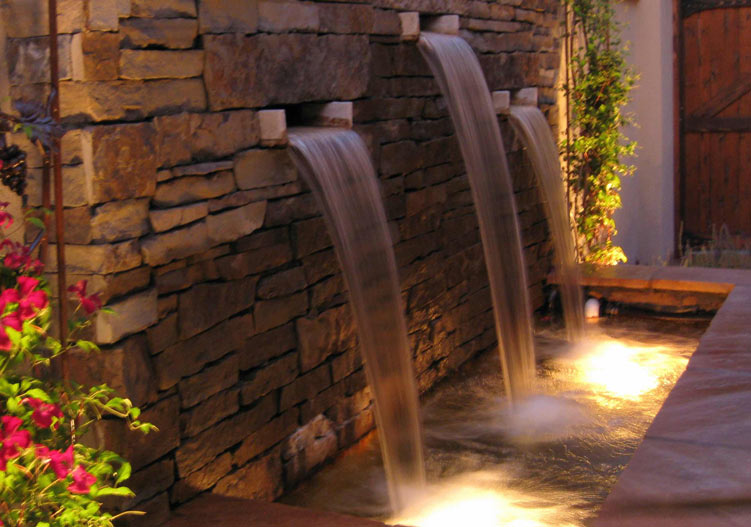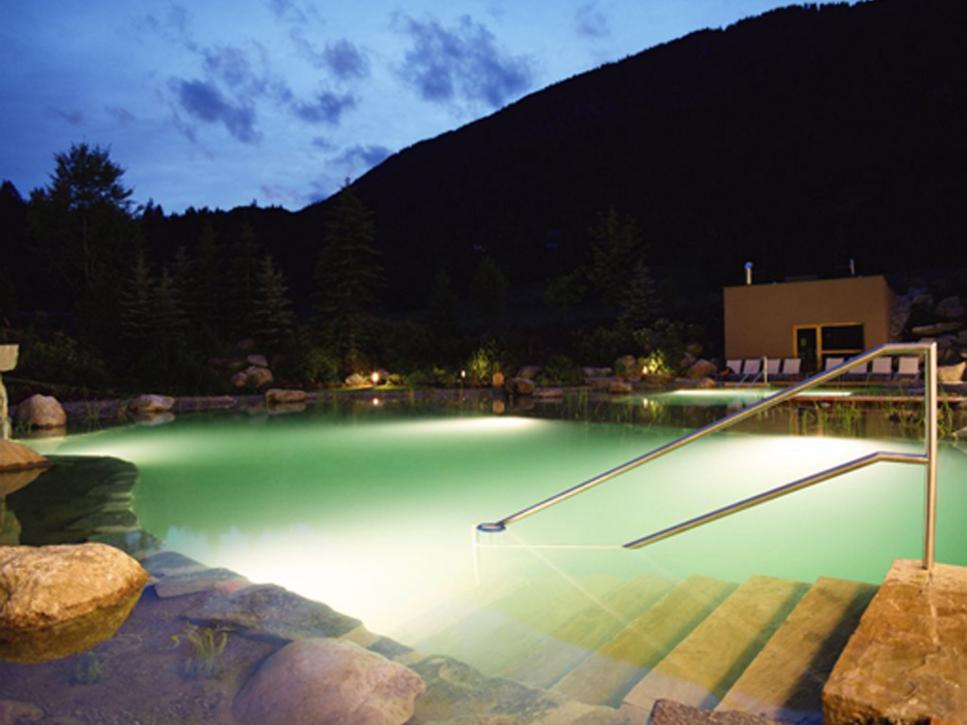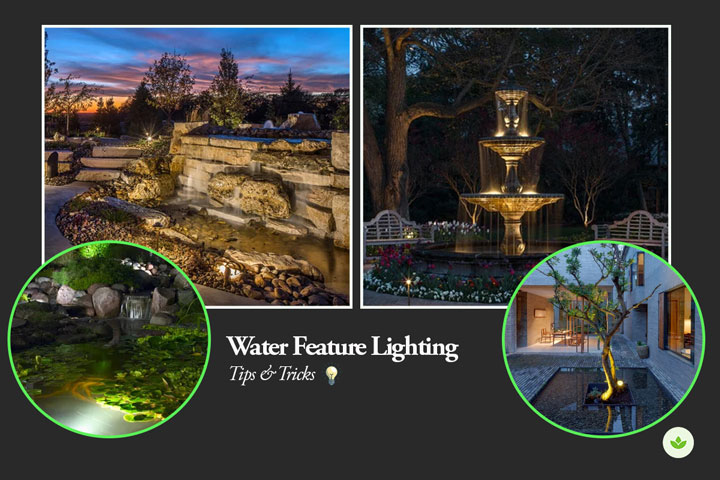Of all the features in a garden, none invokes a sense of serenity as much as water does. Water gardens add excitement and an air of relaxation to an outdoor space. Whether it is still or moving water, water tends to take center stage. It is because of this that any water feature is well served with nighttime lighting, extending the viewing pleasure well into the evening hours.
However creative lighting requires finesse since water feature lighting tends to be the most complex. It is not as simple as installing a floodlight and calling it a day. Consider if the feature should be lit and if so, how. The focus should be on the lighting effect, not the light source.
In this guide, we look at some ways to make your pond, waterfall, meandering stream, tiered fountain, pool or spa come to life in the nightscape. Scroll On.
Why Light a Water feature
There are two main reasons to light your water garden;
- Safety
- Ambiance/Atmosphere
Safety:
Water itself can be dangerous, particularly for children and pets. Lighting is key to enhancing safety at night.
Underwater lighting marks the water’s edge. Lighting paths, bridges, stepping stones, and banks make the routes clearly visible and illuminate potential hazards at night.
Ambiance:
Far from safety, water garden lighting serves to set a certain mood or atmosphere in the outdoor space. The kind of lighting you select should match the desired ambiance.
A water feature can either be lit with underwater lights, externally, or both. Submerged lighting enhances aquatic life and adds ambiance due to light diffusion. Exterior lighting accentuates the surrounding landscape; marginal plantings, a specimen tree, a pergola, an arbor, you name it. However, submerged light fixtures are costlier and require more maintenance.
Design considerations
When designing a water feature lighting, it is crucial to evaluate the role it plays in the space. Often it will be the primary focal point. But in some cases, it may be one of several focal elements. This will inform how it should be lit after dark.
All the viewing points should be identified. If the primary viewing point is inside the house, the water feature’s lighting level should be equal to or higher than the interior lighting for the feature to be clearly visible.
In addition, the water garden’s brightness level should be consistent with the rest of the landscape lighting. The focal points, a fountain, for instance, should have the highest brightness level, 3 to 10 times brighter than the surroundings fill in ambient lighting.
It is also essential to understand the effects of water on light to achieve the desired effect;
- Refraction of light– As light moves from one medium to another with a different density, say from air to water, the angle of flow changes.
- Dispersion of light– As light travels through water, it scatters reducing its intensity. For every 2 inches of submersion, the perceived brightness drops by about 10%. You may need more light than anticipated, especially if the water is deep or the water is murky.
- Aerated or turbulent water– Turbulent water contains air bubbles that interact with light creating a radiant glow that takes on the color of the light source.
- Smooth water flow– Unlike turbulent water, smooth sheets of water lack air bubbles. Light hitting the water either passes through it or reflects off its surface depending on the angle. For smooth waterfalls, lighting should be directed from the front, with fixtures either in or out of the water.
Still Vs Moving Water
A water feature can either be still or running, falling, bubbling, spouting, or spraying. Let’s look at how each should be lit;
- Moving water– Moving water contains air bubbles that scatter the light creating a glowing effect. When lighting bubbling water, the beams of light bend randomly, resulting in shimmering, play, and dancing lighting effects on the wall, the fountain, and the surrounding foliage.
- Still Water– Completely still water is a rare occurrence. Water tends to exhibit motion even with the gentlest breeze. Even then, water possesses a unique ability as a canvas for reflecting light. Acting as a mirror, the water reflects nearby illuminated features, be it a rock garden, stature on the margins, plantings, glimmers of moonlight, or illuminated pagoda stone lanterns. This is known as mirror lighting, a timeless effect in zen gardens. In addition to mirror lighting, a still pool of water can be lit from below, emphasizing the pool’s shape. Floating luminaires or low-voltage lit globes are also popular for still-water surfaces. These globes exude beauty and are simple to install.

Water Garden Lighting Techniques
Ponds, waterfalls, and fountains can be lit from above, below, or on the sides of the water. The lighting effects differ radically, as do fixture costs, installation, and maintenance.
Underwater lighting:
Submerged light fixtures illuminate the water from below, creating a beautiful effect and showcasing swimming fish. The fixtures can sit directly on the pool bottom, either recessed or above the floor, or the sidewalls.
The effectiveness of underwater lighting hinges on water clarity. If your water contains an abundance of algae, the lights may have a dull green or yellow glow. As such, it is essential to maintain a high-quality filtration system to keep the water reasonably clear.
Minor discoloration is normal, even in well-filtered pools. You can give the water a fresher look using a pale blue filter with the fixtures.
In natural and informal pools, underwater lighting is often ineffective due to the lack of clear waters and the presence of floating debris. Murkiness in the water can mask the light output, and weeds may quickly grow over the luminaires, diminishing their effectiveness. A better approach for murky waters is to create a mirrored effect by illuminating the marginal plantings and statuary to reflect off the dark water surface.
Exterior Lighting
Where underwater lighting is ineffective, exterior lighting is the next best option. Exterior lighting tends to be less dramatic but can be quite effective. In addition, it simplifies installation and maintenance by quite much.
You can effectively highlight features like rocks, specimen trees, low-growing hostas, and pathways in the water garden. This can be through downlighting from trees or architectural structures or placing lights at ground level around the water feature aimed toward a marginal feature.
With exterior lighting, agitated water absorbs and diffuses the light making the water glow and also reflecting some lighting, creating a sparkle on the water’s surface. Water cascading over falls or from fountains sparkles and reflects light shining at it. Still water acts as a mirror, reflecting lit objects surrounding the water.
But remember, you can choose between external or underwater lighting or a combination of both to fascinating effect. It is best to have separate circuits for exterior and underwater lighting. This way, garden features can be beautifully reflected off the water surface when underwater lights are off.
Mirroring:
As I alluded to earlier, mirroring, produced by casting light (downlight or uplights) on subjects adjacent to the water body, is one of the most theatrical water feature lighting techniques. It works best on still water bodies. A dark and still water surface serves as a mirror for the reflections when viewed from the opposite end of the pond or lake.
Mirroring is especially effective when lighting subjects like urns, statuaries, and architectural features.
Trees can also produce stunning effects if the water body is sufficiently large. Even features such as plantings, pergolas, or arbors beyond the water’s edge can be bathed in subtle lighting to reflect off the dark water’s surface.
Water features to light
A water garden can include one or more of the following:
- Waterfalls
- Fountains
- Swimming pools
- Ponds (both man-made and naturally occurring)
- Streams or rivers
Each feature is unique and each offers a multitude of lighting possibilities. The key lies in examining individual components and determining suitable lighting effects for a cohesive lighting plan.
Waterfalls
A waterfall can be lit by a submerged light source. This casts a dancing glow on the rock face and marginal plantings.
Strategically position the luminaire just behind the cascading water concealing the fixture within the luminescence of the foaming water. Since water bends light, you will have to experiment with various angles to capture the water’s sparkle and peak of motion.
For external lighting, aim the light where the falling water hits the horizontal surface to catch the air bubbles and highlight the movement of water effectively. In some cases, we use precision uplighting from rocks near the waterfall to illuminate the flowing water. But one pitfall you must avoid is lighting the fall from behind. This only casts a nasty glare on the viewer, window, or pathway.
If your fall is artificial by design, feel free to incorporate color and other effects for a truly captivating display.

Wall waterfall lighting
Fountains
When lighting fountains, you can use submerged or external lighting. Whether lighting a simple jet fountain, a millstone bubbler, or an elaborate sculptural piece, there are numerous lighting opportunities.
- Jet fountains usually come with built-in lights using water flow to conduct a beam of light.
- Sculptural fountain- focus the lighting on the sculpture itself; showcase its shape and texture by uplighting from a suitable distance while avoiding harsh shadows. Match the number of lamps and beam spreads to the size of the feature and viewing points.
- Tiered fountains- light both the fall of water and the upper-tier features using separate sets of luminaires. Carefully position the lights to avoid harsh shadows.
- Wall fountain- Be cautious in lighting the water spout to prevent undesirable shadows. Narrow or medium beam lamps can accent the mask against the surrounding surface, while wider beam lamps offer shimmering light below moving water.
- Cobble fountains are perfect candidates for uplighting. They feature decorative layers of cobbles, flint, and pebbles over a supporting grid, providing an excellent spot for hiding fixtures. Consider using an internal glare louver to prevent glare if the fountain is close to a viewing position.
- For an urn bubbler where water gently trickles down the side, using underwater lighting inside the urn creates shimmering uplighting on an overhead canopy or structure. A more effective approach is to uplight the trickling water on the outside. Position the light slightly away from the urn’s side and opt for the widest beam lamp available and a frosted lens to diffuse the light. The bubbler can also be lit by downlighting from a wall or pergola.

Bubbling fountain lighting
Ponds
One way to illuminate a pond is with one or two wide-beam spread underwater lamps concealed among the rocks.
But most ponds tend to have murky waters, which may not look pleasant with underwater lighting. You can use subtle exterior lighting to highlight features around the pond casting a play of light and shadows on the murky water surface.
It is also important to consider the effect of lighting on aquatic life. Brightness may affect the well-being of fish. This can be controlled by planning some ways for the fish to escape the bright lights or by not lighting a section of the pond.
Another concern is the heat generated by the lamps on the water temperature. Incandescent lamps produce heat and can significantly warm the water to the detriment of the fish. This should not be a problem if the body of water is large enough or when using LEDs.
- For more on Pond Lighting, click here.

Pond Lighting
Swimming Pools
The key to pool lighting is creating a consistent gentle glow across the pool without overwhelming the overall lighting scheme.
You can illuminate the pool from within using low-wattage wide-beam spread sidewall-mounted submersible lamps. Alternatively, you can highlight the surrounding landscape features with downlights, uplights, and wall lights, utilizing the dark pool surface as a reflective mirror. Or, combine both approaches for a cohesive design.
Make an effort to accentuate the features that make your pool unique, be it a spa, tanning shelf, or grotto waterfall.

Streams
Streams come to life with nighttime lighting.
Typically, streams lack the depth of water required to hide underwater lighting. Remote lighting techniques are often used by lighting from above or the side.
If there is an overhead or nearby structure or tree, use a lamp with a medium-angle beam spread to provide downlighting or moonlighting. The moonlit effect is both widespread and diffused. Most importantly, it produces a silvery sheen on the surface of slow-flowing water.
Pathways & Surrounding
Any form of water garden lighting cannot be complete without illuminating the surrounding features and paths. Path lights highlight low growth and ensure safe passage to and around the water feature.
When dealing with access points such as stepping stones or bridges across a stream or a pond, thoughtful lighting is crucial. Placing narrow beam path lights alongside the stepping stones can effectively mark the way ahead.
Simple bridges can be beautifully illuminated by underwater lights to uplight the underside of the bridge. These define the edges and structure of the bridge. Alternatively, you can use spike-mounted spotlights positioned at an acute angle to light the bridge and the walking surface. For a more natural look, consider moonlight from waterside trees

Fixture selection
There are a plethora of water lighting options; from ring fountain lights to strip lights for waterfalls and submersible pond lights.
Let’s look at some of the factors to consider when selecting a fixture for your water garden.
Lumen output
Be sure to match the lumen output with the feature to be lit. If the water feature is intended to be the main attraction, allocate brighter lamps to make it stand out as a focal point and to punctuate the space. If it is not a focal point, we provide soft general illumination and fill-in lighting for balance, functionality, and safety.
Luminaires with adjustable lumen outputs (dimming capabilities) offer personalized control over light intensity depending on the water depth, and clarity, and for unique features like grotto waterfalls, bubblers, and fountains.
Moisture protection
Submersible luminaires should be fully water-protected (IP 68 rated) and ETL or UL-tested for water intrusion. Even luminaires places near the water’s edge are susceptible to water intrusion and splashes.
While no underwater fixture is 100% leak-proof, an IP68 rating provides maximum protection to the lamps, sockets, and other internal components against water intrusion.
Construction & finishes:
Water feature lighting luminaires should be robust, corrosion-resistant, UV-resistant, and should and meet all safety standards set by NEC®.
. You can choose from materials such as UV-stable plastic, aluminum alloys, brass, or stainless steel.
- Composite plastic and ceramic fixtures are affordable but are prone to cracking due to temperature fluctuations and UV damage.
- Aluminum fixtures are less common because they are susceptible to corrosion, even with protective treatments like powder coating.
- Stainless steel, however, due to its chromium content, resists corrosion and is an excellent choice for long-standing performance.
- Brass, a non-ferrous alloy, is an outstanding option. It offers resistance to rust and corrosion making it particularly suitable for marine applications.
Copper is toxic to fish and can leash into the water harming or even killing them. Under no circumstance should copper fixtures be used in your pond.
Be sure to select light fixtures with finishes that blend with the surroundings. The aim is to draw attention to the lighting effect other than the light source.
The lights can be fixed mounted or angled. Angled fixtures allow for added flexibility. Fixtures need to have strong locking mechanisms, such as yoke locks, to maintain the desired aiming angle due to the force of water, whether it is a fall, current, or steady movement of water.
Opt for fixtures that sit on the pool bottom rather than those recessed into it, as this allows for flexible placement
Lamp type:
There are three main types of lamps: incandescent, LED, and fiber optic.
- Incandescent Lamps: Incandescent and halogen lamps have mostly been phased out in favor of LEDs.
- LEDs: Despite a higher initial cost, LED lamps offer remarkable energy efficiency, durability, longevity, and a range of color temperatures. The majority of LED lamps operate at 12 to 15 volts and necessitate a transformer to reduce the voltage from around 120 volts in the US (220 volts in many countries) to 12 to 24 volts.
- Fiber Optic Lighting: Fiber-optic systems are the most intricate and costly to install, having lost significant market share due to the widespread adoption of LEDs. They find common use in upscale pools and hot tubs for achieving effects such as twinkling. Fiber optic technology is advantageous for underwater lighting as none of the electrical components are submerged.
Kelvin Temperature:
Kelvin temperature describes the color (coolness or warmness) of the light. Most lighting practitioners recommend a soft white light (2700 to 3000K) that creates a soft-colored glow.
Although most water features are not lit with vibrant Vegas colors, consider using RGB or the higher quality RGBW color-changing lights. Color can be set for fun effects during special events, parties, and holidays. Any colored effect should be done without overwhelming the overall lighting scene.
Beam Spread:
The beam angle or beam spread refers to the angle of light emitted from a source, varying between narrow spots and very wide flood or wash lights. The height and width of the water feature play a role in determining the lamp’s wattage and beam spread.
Taller waterfalls and fountains benefit from spot distributions (ranging from 5 to 35º) with a more vertical projection. Medium angle beams (36 to 60º) serve to cast an area with general illumination and to accentuate larger features.
Floods and wide floods (>60º) are employed when illuminating from shorter distances and expansive areas, like wall waterfalls with multiple spouts, pools, or broad rock faces.
Keep in mind that the beam spread impacts the lumen output. For instance, a 5-watt spotlight will appear significantly brighter than a wash light with the same wattage when both are used to light the same object from an identical distance.
Control options:
Basic ON/OFF switches, timers, photocells, dimmers, Wi-Fi control, and color-changing abilities provide ultimate control over the lights.
Divide your lighting into zones, allowing for fine-tuning of brightness and timing for each. Through remote and smart controls, you can establish the atmosphere via color, and lumen adjustments (dimming), and establish lighting schedules with a press of a button or through an application.
Installation & Placement
When illuminating a water garden, proper light fixture installation is crucial. It requires strategic placement to prevent blinding glares and the emergence of dark or excessively bright spots.
The placement of underwater fixtures holds paramount significance. The optimal installation depth falls within the range of 2 to 4 inches below the water’s surface. Underwater luminaires rely on water cooling. Thus, full submersion is imperative to avoid lens breakage and premature lamp failure.
Ensuring firm fixture attachment and fastening is essential to safeguard against the impact of water forces or tampering. The fixtures should be supported by a sturdy concrete base. In shallower ponds, attach the underwater light mounting bracket to a paver or block using a brass screw.
Equally significant is hiding the lights from view. This can be done by using the surrounding rocks, plants, hoods, or honeycomb filters (such as louvers or baffles) to effectively conceal the fixtures. Visible fixtures can detract from the desired effect.
Also of importance is concealing all electrical cords. This involves ensuring that the cords remain inconspicuous yet accessible for maintenance purposes.
Electrical connections
Safety should take precedence when working with electricity and water.
Usually, a transformer is used to power the light fixtures, pumps, filters, and pond cleaners. The transformer should be sheltered from the elements and should be easily accessible. Place the transformer and the GFCI outlet at least 10 feet away from the water and ground for safety.
Flexible PVC pipes are useful for convenient wire routing. After connecting your fixtures and low-voltage wires, link them to the transformer and test the system by activating the lights. Nighttime adjustment is needed to achieve the desired effect.
For seamless integration, consider installing the water feature lighting during construction. This way you can optimize fixture placement, concealment, and wiring.
Maintenance
Continual upkeep of light fixtures, whether submerged or above ground, will be necessary. Plants can overgrow and obscure lights, lenses may accumulate algae and become hazy, and cords could suffer damage from animals or cleaning equipment.
Maintenance will involve;
- Cleaning and removing debris and algae
- Inspecting the luminaires for damage and corrosion
- Repositioning the lights
- Trimming aquatic plants
Maintaining underwater equipment should be done outside the water by pulling the fixture out of the water or draining the pool. Opt for fixtures with long cords as they allow for convenient wire connections outside the water for maintenance.
To sum up
Landscape lighting is more than just providing lighting; it creates serenity, warmth, and safety in an outdoor space.
When illuminating a water feature, the adage “less is more” stands true. The aim is to create gentle and inviting illumination without overpowering the space. Focus on the desired lighting effect other than the fixture.
Familiarize yourself with local lighting regulations and secure any necessary permits or licenses. In some areas, licensed electrical contractors might be mandated for low-voltage lighting setups.
While the internet is awash with a wealth of information and tutorials, It is worth consulting the professional expertise of a lighting designer. They can assist you with fixture selection and developing a lighting plan for a simplified process but at a cost.
Each feature is unique and should be lit to bring out its best.


